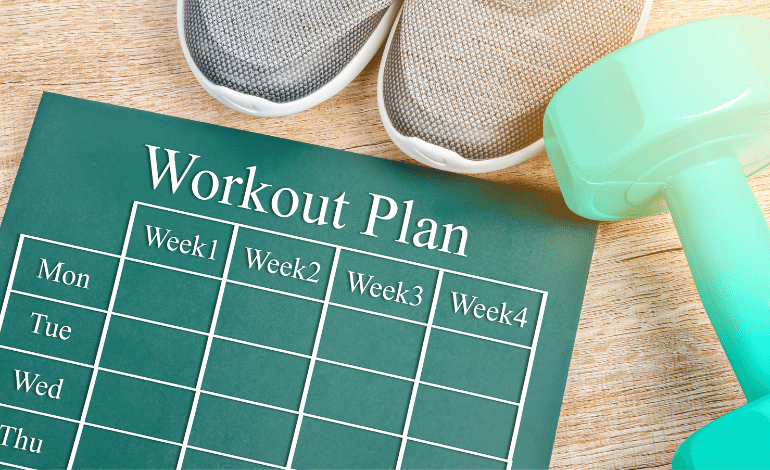How to Design an Effective and Personalized Workout Plan

How to Design an Effective and Personalized Workout Plan: Are you looking to improve your fitness level, but don’t know where to start? Are you tired of generic workout plans that don’t take into account your specific needs and goals? If so, it’s time to design an effective and personalized workout plan that works best for you. A personalized workout plan can help you achieve your fitness goals, improve your overall health and well-being, and boost your confidence. In this article, we’ll provide you with tips and guidance on how to design an effective and personalized workout plan that fits your lifestyle and goals. Let’s get started!
1. Define Your Goals and Objectives
Before you can create an effective workout plan, you need to define your goals and objectives. Are you trying to lose weight, gain muscle mass, increase endurance, or improve overall fitness? Be specific and realistic about what you want to achieve, and make sure your goals are measurable.
2. Consider Your Current Fitness Level
Your current fitness level is another important factor to consider when designing your workout plan. If you’re just starting out, it’s important to start slowly and gradually build up your fitness level. If you’re already active, you may need to push yourself harder to see results.
3. Choose the Right Exercises
Once you’ve defined your goals and considered your fitness level, it’s time to choose the right exercises for your workout plan. Ideally, you should include a variety of exercises that target different muscle groups and incorporate both strength training and cardiovascular exercise.
Strength training exercises can include weightlifting, bodyweight exercises, and resistance band exercises. These exercises will help build muscle mass and increase overall strength.
Cardiovascular exercises can include running, biking, swimming, and any other activity that gets your heart rate up. Cardiovascular exercise is important for improving endurance and burning calories.
4. Determine the Right Frequency and Intensity
The frequency and intensity of your workouts will depend on your goals, fitness level, and time constraints. For example, if you’re trying to build muscle mass, you may need to work out more frequently and with higher intensity than if you’re just trying to improve overall fitness.
In general, it’s a good idea to aim for at least three workouts per week. You should also alternate between strength training and cardiovascular exercise on different days to give your muscles time to rest and recover.

5. Create a Balanced Workout Plan
To get the best results from your workout plan, it’s important to create a balanced plan that targets all of your muscle groups and incorporates both strength training and cardiovascular exercise. A balanced workout plan will also help prevent injury and ensure that you’re not overworking any one muscle group.
6. Incorporate Flexibility Exercises
Flexibility exercises are often overlooked but are essential for injury prevention and overall health. Stretching and yoga are great ways to improve flexibility and should be included in your workout plan.
7. Track Your Progress
Finally, it’s important to track your progress so you can see how far you’ve come and adjust your workout plan as needed. Keep a journal or use a fitness app to record your workouts and make note of any improvements in your fitness level.
Designing an effective and personalized workout plan takes time and effort, but it’s worth it to achieve your fitness goals. By defining your goals, considering your fitness level, choosing the right exercises, determining the right frequency and intensity, creating a balanced workout plan, incorporating flexibility exercises, and tracking your progress, you can create a plan that works best for you. Remember to listen to your body, be patient, and enjoy the journey.
8. Seek Professional Guidance
If you’re new to working out or are unsure about how to design an effective workout plan, it’s a good idea to seek professional guidance. A personal trainer can help you create a customized plan that takes into account your goals, fitness level, and any limitations or injuries you may have. They can also provide guidance on proper form and technique to help prevent injury and ensure that you’re getting the most out of your workouts.
9. Make Adjustments as Needed
Your fitness level, goals, and schedule may change over time, so it’s important to make adjustments to your workout plan as needed. If you’re not seeing the results you want, you may need to adjust your frequency, intensity, or the exercises you’re doing. If you’re experiencing pain or discomfort, it may be a sign that you need to take a break or modify your workouts.
10. Be Consistent
Consistency is key when it comes to achieving your fitness goals. Stick to your workout plan as closely as possible, and don’t let setbacks or obstacles discourage you. Even if you can’t stick to your plan perfectly, try to stay active and make healthy choices as much as possible.
Conclusion
In conclusion, designing an effective and personalized workout plan requires careful consideration of various factors, including your fitness goals, current fitness level, and any limitations or injuries you may have. By choosing the right exercises, determining the appropriate frequency and intensity, creating a balanced plan, incorporating flexibility exercises, and tracking your progress, you can create a plan that works best for you. Seek professional guidance if needed and make adjustments as necessary.
With dedication and effort, you can achieve your fitness goals and improve your overall health and well-being. Remember, consistency is key, so stick to your plan as closely as possible and make healthy choices as much as possible. Get started on your fitness journey today and enjoy the benefits of a healthier, stronger, and more confident you!
FAQS
Q1. What is an effective workout plan?
Ans. An effective workout plan is a personalized plan that helps you achieve your fitness goals, incorporates a balanced mix of strength training and cardiovascular exercise, and takes into account your fitness level, time constraints, and any limitations or injuries you may have.
Q2. How do I design a personalized workout plan?
Ans. To design a personalized workout plan, define your goals, consider your fitness level, choose the right exercises, determine the right frequency and intensity, create a balanced plan, incorporate flexibility exercises, and track your progress. Seek professional guidance if needed, and make adjustments as necessary.
Q3. What exercises should I include in my workout plan?
Ans. Your workout plan should include a variety of exercises that target different muscle groups, including strength training exercises like weightlifting and resistance band exercises, and cardiovascular exercises like running, biking, and swimming.
Q4. How often should I work out?
Ans. The frequency of your workouts will depend on your goals, fitness level, and time constraints. In general, it’s a good idea to aim for at least three workouts per week, alternating between strength training and cardiovascular exercise on different days.
Q5. How do I determine the right intensity for my workouts?
Ans. The right intensity for your workouts will depend on your goals, fitness level, and the specific exercises you’re doing. You can use the talk test or heart rate monitoring to help determine the appropriate intensity.
Q6. Should I incorporate flexibility exercises into my workout plan?
Ans. Yes, flexibility exercises are essential for injury prevention and overall health. Stretching and yoga are great ways to improve flexibility and should be included in your workout plan.
Q7. How do I track my progress?
Ans. Keep a journal or use a fitness app to record your workouts and make note of any improvements in your fitness level, weight, or body measurements. Use this information to make adjustments to your workout plan as needed.
Q8. Can I design a personalized workout plan on my own?
Ans. While it is possible to design a personalized workout plan on your own, it’s a good idea to seek professional guidance if you’re new to working out or have any limitations or injuries. A personal trainer can help you create a customized plan that takes into account your goals and fitness level, and provide guidance on proper form and technique to help prevent injury and ensure that you’re getting the most out of your workouts.








